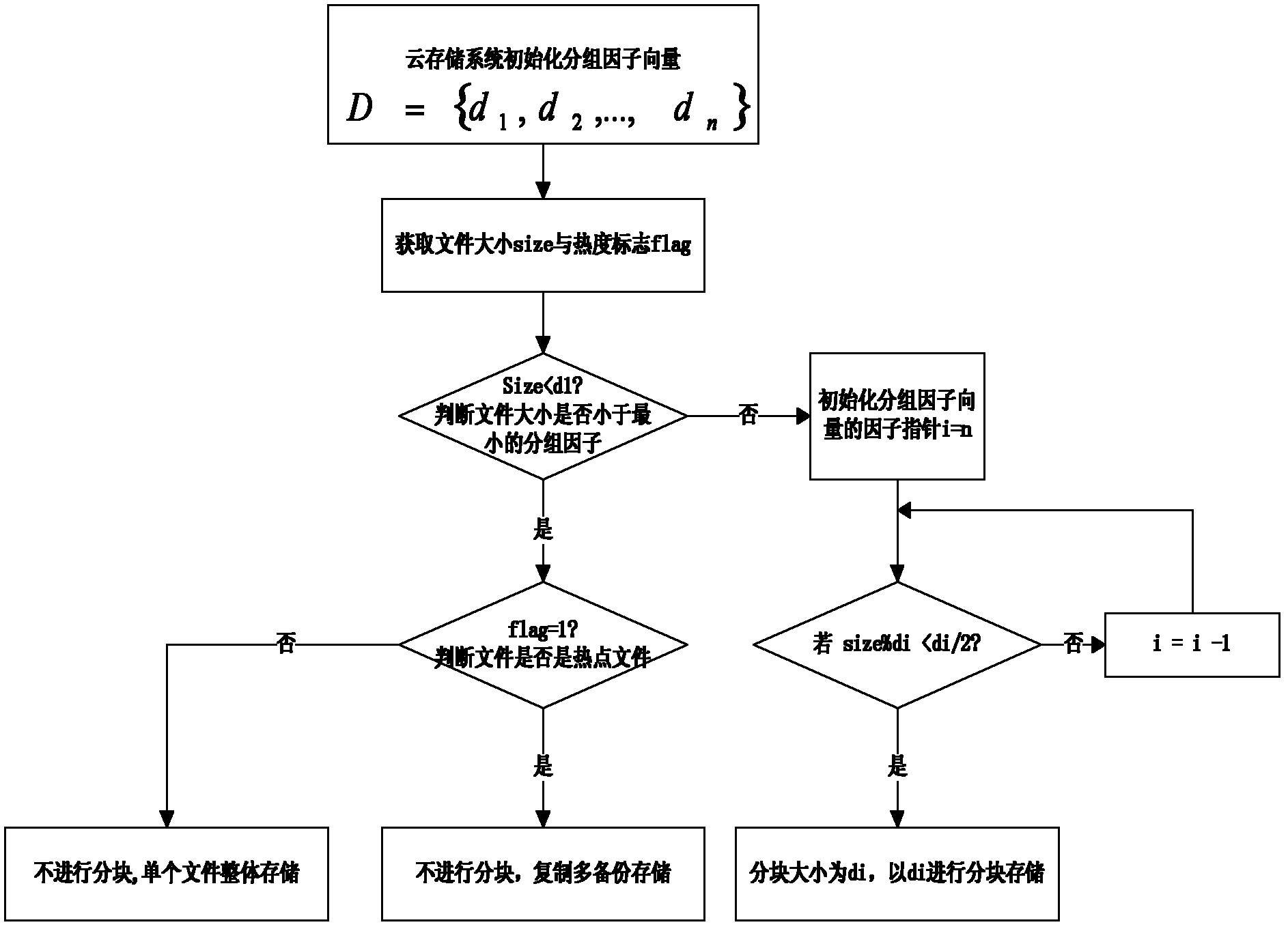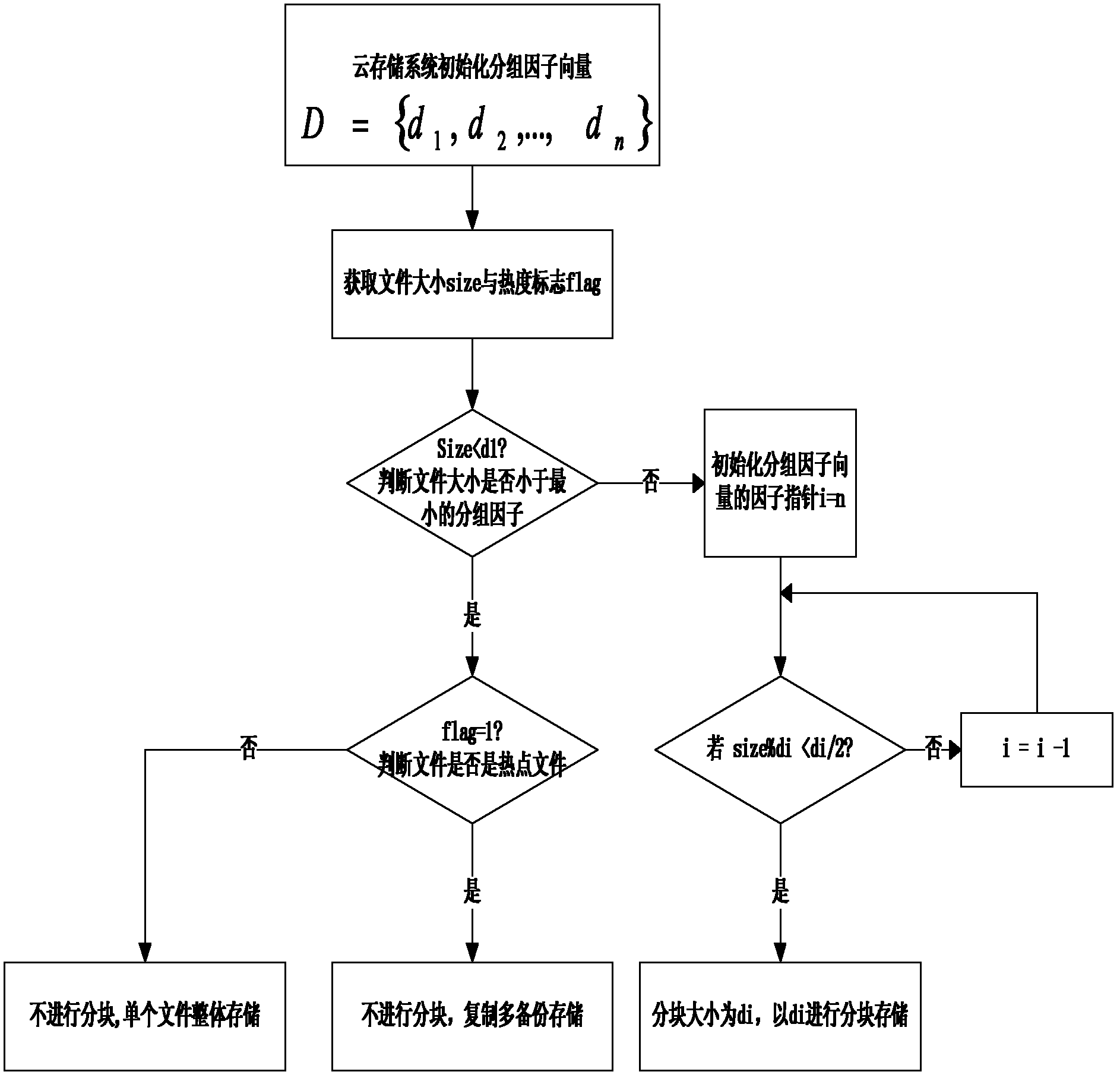Block size variable data blocking method for cloud storage system
A cloud storage system and block technology, applied in the field of communication, can solve problems such as too large access to hotspot files, not a perfect solution, partial system overload, etc., to avoid disk fragmentation, improve space utilization, and solve load overload problems Effect
- Summary
- Abstract
- Description
- Claims
- Application Information
AI Technical Summary
Problems solved by technology
Method used
Image
Examples
example 1
[0023] Example 1: Divide a file whose size is less than 4M and whose heat mark is 1
[0024] Step 1, the cloud storage system determines the best block factor vector as D={d according to experience and cloud application requirements 1 , d 2 ,...,d n}, d i , i=1, 2..., n is n block factors arranged from small to large, in the actual system, the best d i , i=1, 2..., the value of n is: when n=6, take d 1 = 4, d 2 = 8, d 3 = 16, d 4 = 32, d 5 = 64, d 6 =128, that is, D={4, 8, 16, 32, 64, 128}.
[0025] Step 2, the cloud storage system obtains the file size as size, size<4M byte, since the size of the file is smaller than the minimum block factor in the block factor vector D, it does not need to be divided into blocks, and the obtained file block size is is the final size of the file.
[0026] Step 3, the cloud storage system obtains the file heat flag flag=1 again, indicating that the file is a hot file, so it needs to be copied and stored, that is, three backups of th...
example 2
[0027] Example 2: Divide a file whose size is less than 4M and whose heat mark is 0
[0028] Step 1, the cloud storage system determines the best block factor vector as D={d 1 , d 2 ,...,d n}, d i , i=1, 2..., n is n block factors arranged from small to large, in the actual system, the best d i , i=1, 2..., the value of n is: when n=6, take d 1 = 4, d 2 = 8, d 3 = 16, d 4 = 32, d 5 = 64, d 6 =128, that is, D={4, 8, 16, 32, 64, 128}.
[0029] Step 2, the cloud storage system obtains the file size as size, size<4M byte, since the size of the file is smaller than the minimum block factor in the block factor vector D, there is no need to block, and the obtained file block size is is the final size of the file.
[0030] Step 3, the cloud storage system obtains the file heat flag flag=0, indicating that the file is not a hot file, so the file is directly stored on a storage node, and the storage ends, that is, the block method ends.
example 3
[0031] Example 3: Divide files larger than 4Mbyte into chunks
[0032] Step A, the cloud storage system determines the best block factor vector as D={d according to experience and cloud application requirements 1 , d 2 ,...,d n}, d i , i=1, 2..., n is n block factors arranged from small to large, in the actual system, the best d i , i=1, 2..., the value of n is: when n=6, take d 1 = 4, d 2 = 8, d 3 = 16, d 4 = 32, d 5 = 64, d 6 =128, that is, D={4, 8, 16, 32, 64, 128}.
[0033] Step B, the cloud storage system obtains the file size as size, size > 4Mbyte, since the file size is greater than the minimum block factor in D, it needs to be divided into blocks, and step C is performed.
[0034] Step C, according to the 6 block factors contained in the block factor vector D={4, 8, 16, 32, 64, 128}, so d 6 =128 is used as the initial block factor to start block judgment, that is, the grouping factor d 6Compare with the size of the file, if size%d 6 6 / 2, the block size i...
PUM
 Login to View More
Login to View More Abstract
Description
Claims
Application Information
 Login to View More
Login to View More - R&D
- Intellectual Property
- Life Sciences
- Materials
- Tech Scout
- Unparalleled Data Quality
- Higher Quality Content
- 60% Fewer Hallucinations
Browse by: Latest US Patents, China's latest patents, Technical Efficacy Thesaurus, Application Domain, Technology Topic, Popular Technical Reports.
© 2025 PatSnap. All rights reserved.Legal|Privacy policy|Modern Slavery Act Transparency Statement|Sitemap|About US| Contact US: help@patsnap.com


